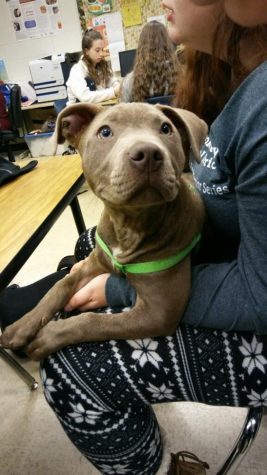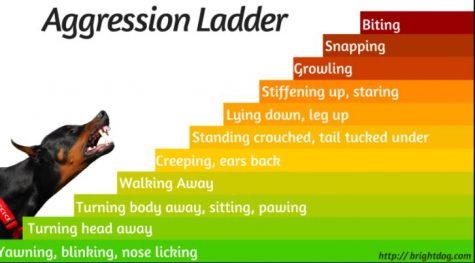“The Most Dangerous Game”…in real life
May 17, 2017
A long day. At the end of it, you crawl into bed, pulling the covers around you, burrowing under to stay warm. Drifting to sleep, your dreams are of happy times, delicious food. Suddenly, a sharp pain stabs your side. Groggy, you wake from your deep sleep. Blood oozes from a gaping wound in your side. You are bleeding. Someone has shot you! Scared, you cry out for your children. Silence. The only sound your ragged breaths as you gasp for air. Wounded, unable to move, you are in unbearable pain. A shape appears in the cave-like darkness. A human—moving closer to you. A knife, still warm from your blood, slices through the air as it rips at your skin.
Someone is skinning you alive.
You may think this seems like fiction, but for animals, this is a very real danger.
In March, the Senate sent H.J. Resolution 69 to President Trump’s desk. On April 3, he signed it into law, allowing hunters to use gross and inhumane hunting tactics such as shooting hibernating bear and wolf families in their dens.
“What the House did today should shock the conscience of every animal lover in America,” Wayne Pacelle, CEO of The Humane Society of the United States, said in a statement.
The repealed law was put in place in order to maintain the bear, wolf, and coyote populations in Alaska. Studies showed that each population was slowly declining, and the Fish and Wildlife Service wanted to do something to get the numbers back up.
“We have to recognize this is not about the little polar bears, the little grizzly bears or wolves on television, this is about the state’s right to manage — not allowing the federal government to do so. We want to be able to take and manage our fish and game for the sustainable yield — so that our fish and game will be there forever,” Don Young, Alaskan House Representative who spearheaded the bill, said.
Many animal rights activists, shocked and angry at Trump and Congress for allowing the bill to become a law, protested the obscene law by rallying, emailing, mailing letters, and tweeting.

This is not the only law that has outraged animal lovers. According to PETolog.com, many local lawmakers have made hundreds of laws restricting the ownership, even banning in some places, certain dog breeds such as German Shepherds, American Pit bulls, and Rottweilers.
These laws are known as BSL, or Breed-Specific Legislation, though the laws are based on appearances, not necessarily breeds. The dogs mentioned are usually perceived as “dangerous” breeds of dogs. In other words, there are no laws banning Poodles or Pomeranians.
“Almost all BSL also includes a ‘substantially similar’ clause: ‘or any dog with an appearance or physical characteristics that are substantially similar to the aforementioned breeds.’ In other words, targeted dogs are often subject to BSL not because they are in fact a specific breed, but because they simply look similar to a particular breed or have a general physical appearance that someone might consider ‘targeted breed-like,’ Fred Kray, writer for StopBSL.org, said.
“[BSL] is the most stupid thing ever. Dogs have never done anything but be our best friends. Sam [was the] best decision ever,” sophomore Kimberly Pallas, German Shepherd owner, said.

If a banned dog is found living within the area in which the ban is implemented, most of the time they have to be put down by animal control. Relocation is the only way for them to be saved from certain death. Restrictions are the most common type of BSL. Muzzling a dog in public, posting vicious dog signs outside of houses, even purchasing liability insurance are among the many restrictions placed.
“[My] supposedly aggressive dog has shown me that all of the legislators that have been banning pit bulls are very wrong in doing so. These animals are only dangerous when they are not trained in a proper, consistent manner. I truly believe that these laws and restrictions should be removed, because any dog can be aggressive and dangerous if not given the care and love they deserve,” senior Kali Brooks, Pitbull owner, said.
Many other dog owners agree. As John Grogan, author of “Marley and Me” says, there are no bad dogs, only bad owners.
“Our dog Dia used to be a bait dog for dogfights, and she was treated horribly and barely able to live. Once we gave her a good home and treated her right, it was almost like a completely new dog. I think that’s a big issue when it comes to these breeds because a lot of people will buy them and train them to be violent towards other people,” senior Emily Silver, Rottweiler owner, said.
Yet, many people still are afraid of certain types of dogs because of the stigma surrounding them. As with any animal, dogs will attack if afraid or provoked. It is their fight-or-flight instinct kicking in. The best way to prevent that from happening is to read the signs. What are those signs? Find out by reading the next installment.

Six signs of aggression
Man’s best friend. The one that will be there for us when no one else is. The one that comforts you when you are down, who only wants a belly rub and some TLC. Dogs can be the miracle you need in your life, yet many people are afraid of them because of the aggressive behavior they show at times.

According to the ASPCA, these are the most common signs of aggression:
- A threatening sounding bark
- Lunging forward or charging
- Growling
- Showing teeth
- Bumping your body with their nose
- Becoming very still and rigid
There are different types of aggression. Dog owners need to ask these questions in order to understand the type: Who or what was the aggression directed toward? Where did it happen? When did it happen? Did something stop the aggression?
The answers to these questions will help provide insight into the reason for your dog’s aggression.
Territorial aggression occurs if a person enters the dog’s personal space unexpectedly. This could be someone the dog knows or an intruder in the house. Protective aggression can occur if the pet feels that its owner is in danger.
Possessive aggression occurs when the animal feels threatened over its belongings. It may guard its things heavily, and not allow anyone near them. Fear aggression occurs when pets feel cornered or trapped, and may attack due to their fight-or-flight instinct.
“Territorial and possessive aggression are the most common types of aggression. Dogs are domesticated creatures, so it makes sense that some of their wild instincts are still in their bones,” Jennifer Monroe, Veterinarian, said.
Pain-elicit aggression may occur when pets are in pain and lash out due to it. Social aggression can occur if a dog views itself as higher up in “status” in relation to other family pets.
Professional behavior experts are great tools to use when figuring out how to quell your dog’s aggression. All dogs can be aggressive, so do not shove it into the back of your mind if your Toy Pomeranian begins growling and showing its teeth. Pay attention to the signs.
